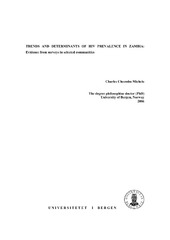| dc.description.abstract | HIV epidemics continue to represent a public health threat worldwide, leading in causing deaths in sub-Saharan Africa. UNAIDS has largely relied on the ANC based sentinel surveillance system to estimate the magnitude, patterns and trends of the HIV/AIDS epidemic. Knowing the magnitude of the disease problem is cardinal in all surveillance systems. One way of understanding the distribution and determinants of the HIV infection is to carry out studies on trend and focus on both individual and group level characteristics. Disease trends provide information about the past and current spread, and may be extremely useful in predicting future patterns of the disease, which in turn is important in adjusting public health policy and interventions. Establishing a functioning surveillance system is the best way to do this. However, although extensive work has been carried out on the epidemiology of individual risk factors of HIV in Zambia, work on patterns and trends of infection with focus on behaviour and exposures, has been limited. Furthermore, of the available work, a large proportion of it has not been guided by conceptual frameworks from data collection, analysis to interpretation of key associations between variables. Employing a framework forms a strong validity foundation on the interpretation of associations between variables. The aim of this thesis was to examine trends of HIV infection, explore factors that are associated with the transmission of HIV, evaluate magnitude and direction of potential biases associated with such surveys as well as to investigate whether antenatal (ANC)- based HIV prevalence can be extrapolated to the prevalence trend of men and women in the general population. In achieving these objectives, the proximate-determinants conceptual framework was applied as a guide. In Zambia the HIV epidemic has been predominantly monitored using cross-sectional surveys that include both ANC-based sentinel surveillance and population based surveys (PBS). The ANC-based surveillance system was established in 1990 with a few sites, and was conducted thereafter in 1994, 1998, 2002 and in 2004. In Kapiri Mposhi and Chelstone, a series of cross-sectional surveys on HIV prevalence and risk factors were also conducted in 1995, 1999 and 2003 among randomly selected men and women. The data used in this thesis stem from the respondents in 1995 (n=3158), 1999 (n=3731) and 2003 (n=4751) aged 15-59 years who had completed the questionnaire and had a validated saliva test result for HIV. However, Chelstone was the only site that had both ANC-based and population-based HIV prevalence estimates from the same population consistently. Thus, when investigating to what extent ANC-based estimates pick HIV prevalence trends among men and women, only ANC data from Chelstone (n=450, n=810, n=786 respectively) was validated with appropriate population-based data. In general prevalence declined in all age groups but the decline was most convincing in young people aged 15-24 years. In this age group, prevalence declined by 59.2% (P<0.001) among rural females, by 44.6% (P<0.001) in rural males, by 47% (P<0.001) in urban females and by 57.3% (P=0.001) among urban males. It was further observed that these HIV prevalence declines were concentrated in groups with higher education. In 2003, young people with higher education had lower odds of infection than in 1995 in both urban [men: AOR 0.29(95%CI 0.14-0.60); women: AOR 0.38(95%CI 0.19-0.79)] and rural groups [men: AOR 0.16(95%CI 0.11-0.25), women: AOR 0.10(95%CI 0.01- 7.34)]. Furthermore, urban young people who attended school for ≥11 years, reported increased use of condoms during the last casual sex (AOR 2.96 95%CI 1.93-4.52) over the period. Similarly, young people with higher education less often reported any casual sexual partners in the last twelve months (AOR 0.33; 95%CI 0.19-0.56) than groups with lower education. In addition, there were substantial delays in childbearing observed in this group in both the rural and urban areas. The most significant cause for nonparticipation was absence in men, but refusal to provide saliva remained <10% in all survey rounds in both sexes. The group of participants reporting to be highly mobile was used as sentinel of HIV infection for men who were absent. However, it was observed that even in these mobile groups there were significant prevalence declines in urban men and less prominently in the rural men. Notwithstanding the presence of selection biases due to non-response, they are unlikely to be an important factor explaining the sharp HIV prevalence declines among young people. ANC-based data understated HIV prevalence for the general population. ANC-derived prevalence in Chelstone only declined by 20% (25.0% to 19.9%; P=0.101) in age group 15-24 years and was stable overall. In sharp contrast, population-based HIV prevalence declined by 44% (P<0.001) and by 27% (P<0.001) in age group 15-24 and 15-49 years respectively among women only. These declines were concentrated among higher educated women (P<0.001). Furthermore, in age group 15-19 years, the proportion of women ever given birth declined by 57% (AOR 0.43 95%CI 0.26-0.68) over the period. The observed declines among young people were consistent with behaviour change. The observed parallel between HIV prevalence declines and behaviour change is a positive sign indicating that prevention programs in Zambia are bearing fruit. The concentration of the declines in young people with higher education suggests that the declines are due to behaviour change rather than increased mortality. Therefore, the power of educational attainment in reducing the HIV incidence by modifying people’s behaviour should not be under-estimated. In addition, the stable risk among groups with less education might also indicate limitations in reaching some groups in the past. Lastly but not the least, the under-estimation of declines observed among ANC attendees requires further research. | en_US |




